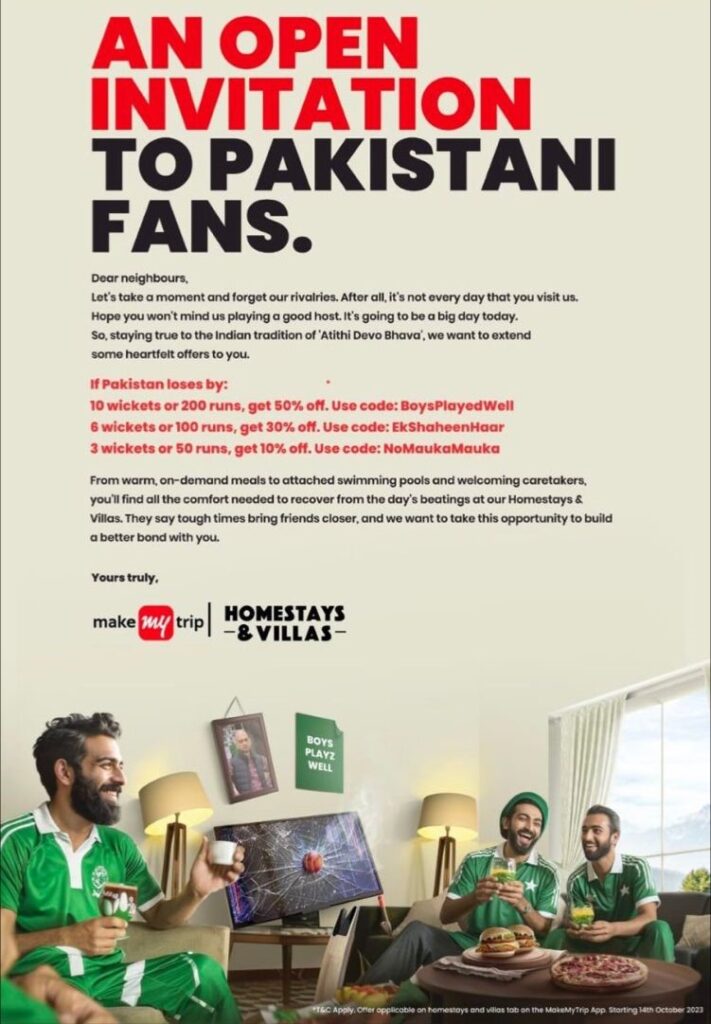Our Overton Window has shifted; if politics, society and culture lead, marketing is bound to follow.
There has been much commentary on the MakeMyTrip print ad that graced several newspapers on the day of the India vs Pakistan world cup cricket ODI fixture on 14 October. As you may have observed, the commentariat is divided.
There are several who like the ad – it was a success by all measures, virality, reach, good art, and copy (apparently), and it was safe. Safe, because it dunked on Pakistan, a sentiment that is perfectly acceptable in India. It also had the kind of backslapping humour that many of us like, the kind that you’ll find in men’s WhatsApp groups, but without the sexism. No marketer was hurt or threatened because of it, and no boycott calls were made. In fact, it worked out very well for both agency and the brand (see this LinkedIn post by the CEO of the agency that made the ad. We also don’t see much social media outrage outside of the marketing community.
Then there are those who didn’t like the ad. They found the humour distasteful; it was a hit below the belt, especially for a cricket team that was expected to lose anyway; it was a familiar and lazy old trope – a take-off on the successful Star India ‘mauka-mauka’ ads and advanced a stereotype of Pakistanis – bearded men, prone to violence (broken TV set), and the “boys played well” on the wall. The coupon codes and hashtags that offered discounts got people’s goat.
(if you are too young to know the origin of the “boys played well” joke, here is the original video of the phrase)
See the ad below for yourself.

One could deeply examine the ad and identify the parts that make it good, or bad. In critical comments and updates on LinkedIn and other social media, and in a couple of WhatsApp groups that I belong to, the overwhelming concern has been that “this is not us. This is not in good taste. A good marketer would never do such work (for reasons already cited above), it does nothing for the brand,” so on and so forth.
I see this ad as part of two things – one, a larger trend in marketing and advertising that indicates that certain taboos don’t exist any longer and two, marketers are susceptible to political, social, and cultural changes as any other individual or group. To put it plainly, marketers are increasingly not averse to putting out messages that are prejudiced and majoritarian – and they are either being pushed in this direction, or their own values are shifting.
Diversity, oh that ‘woke’ thing, matters
Indian advertising – as in much of advertising elsewhere – has typically targeted the moneyed, who in India are overwhelmingly upper caste and upper class. The marketing-speak reason for this is that product positions are usually ‘aspirational’. If we are dark, it is assumed that we would naturally aspire to be fairer, if we are poor, we would want to be rich, and if we are lower caste, it is quite natural that you want to be an upper caste in your next birth. Most models are fair complexioned, fictional advertising characters have gupta-chopra-sharma-varma surnames with the odd Nair and Iyer and occasionally Khan, and live in fancy homes, have fancy cars, attend fancy events and all such. They also exclusively celebrate festivals, occasions, and weddings in typical upper caste style. Do you remember the last time you heard a Dalit or lower-caste surname, a dark-complexioned model outside of a specific poverty-related context, or a Buddhist or a Muslim wedding on a mainstream ad? You would have to search for such takes.
That the marketing and advertising industry lacks caste and class diversity is a given, and while the caste-blindness is generally subtle, it is sometimes explicit. What does this lack of diversity and inclusion do? It produces work like the ad that provoked this post. More importantly, it can help prevent ideas like the infamous ‘kachra’ ad by Zomato from taking root.
This story by Sanjana Ramachandran documents some of the insensitive advertising published over the past few years
Entry of the outrage machine
It would be hard to put a definite start date to this trend. There was a time, not too long ago, when commercial advertising depicted, among other values, communal harmony, social change and national integration. If you are of a certain vintage, you might remember this ad of a product of a certain vintage, the iconic “hamara bajaj” campaign TVCs that aired frequently on Doordarshan. One can’t say what difference it made to the dominant scooter brand of the day, but the line “Buland Bharat Ki Buland Tasveer… Hamara Bajaj’” is evocative of the zeitgeist of the 1990s. Many of us carry fond memories of the time when TV switched from staid Doordarshan to a plethora of new channels – even as the papers headlined the militancy, communalism, and political instability around the country. You’ll also remember the famous “Mile Sur Mera Tumhara” and the “Freedom Run” shorts from this era. More recently, Nike ran the high-risk Dream Crazy ad featuring Colin Kaepernick right in the middle of #BlackLivesMatter. It worked out well for Nike, though – the ad won an Emmy and boosted Nike’s revenues.
imagine a brand taking such a stand in present-day India. You can predict the first question that will most likely come from a right-wing social media influencer: how dare Bajaj imply that the country is not united? #BoycottBajaj
The power of the ‘hurt sentiment’ has been around in popular culture for several generations. The outrage around Salman Rushdie’s ‘Satanic Verses’, despite having taken place in the 1980s continues to have an impact even in 2023, almost fifty years later. There are similar examples – the threat to MF Husain who had to live out his old age in exile is another one. In recent times, there has been outrage on much less, such as a boy kissing a girl with a silhouette of a temple in the background in a Netflix series, or a film star wearing pastel colours at her wedding.
However, outrage at advertising – a dour creative activity aimed primarily at getting you to buy a product – has been relatively rare. Perhaps the internet and the rise of social media provided the platform with which like-minded people (or agents, in academic speak) could organize themselves and make a tangible impact on a brand’s reputation and force the business to address the hurt to their sentiments.
The most prominent and one of the earliest manifestations of this trend was the outrage directed at what is quite obviously a carefully scripted, well-produced and tested advertisement that marketed Surf Excel by Unilever. The film, a take on Surf Excel’s ‘daag acche hain’ positioning, depicts a celebration of Holi, which in 2019, coincided with Eid. A girl child ensures that her friend, a Muslim boy, does not get colours thrown on his pristine white outfit till he is done with Eid prayers at the mosque. One wonders how this film could depict anything other than cuteness and communal harmony and invoke #LoveJihad, but for some people, it apparently did. This commentary on the outrage is worth reading.

Then there is the famous ad by a jewellery brand that showed a Hindu woman in a Muslim family which unfortunately attracted threats of violence and had to be taken off air. We have had influencers directing their invective at advertising that hints at upturning tradition, brides who don’t look happy, and even Indian festivals not looking festive enough. If you thought this trend originates only from right-wing voices, here is a seasoned ad man lamenting that advertising no longer depicts Indian women wearing bindis or sarees
If the internet and social media are the tools that fuel such outrage, these events are likely to make marketers play safe by keeping away from topics that could hurt sentiment even remotely – even if the messaging is otherwise positive – and, eventually move towards advertising that will be based on what they decipher as popular sentiment.
You can literally see this in the note explaining the MakeMyTrip ad. Read this line: “when we were making the print ad we were making it for the likes of the millions of people in front of their TVs yesterday. Sports fanatics but possibly not purists.” The whole note is worth dissecting, but this line alone has the gist: it implies that the ad is not made for self-appointed critics who reside only on LinkedIn but for the millions of others who would love this kind of humor along with their cricket. Does this qualify for ‘popular sentiment’?
You are free, though, to interpret his statement differently.
It isn’t the last
In other LinkedIn updates and WhatsApp conversations, many of the infamous ‘LinkedIn crowd’ who didn’t like the ad said that they wouldn’t approve of this kind of advertising, the reasons for which I have stated already. Some have argued that marketers had the responsibility to influence attitudes and persuade audiences through mature and meaningful messaging and not exploit base tribal tendencies. While well-intentioned, one can easily see a basic flaw in this argument: do marketers want to assign such responsibilities to themselves? Isn’t it just easier to pander to popular taste, settle for low-effort humour and go viral?
The MakeMyTrip ad isn’t the first one to tread this path; it won’t be the last, and worse ones are on their way.
[Disclaimer: views expressed herein are my own and not those of my employer]

Leave a Reply